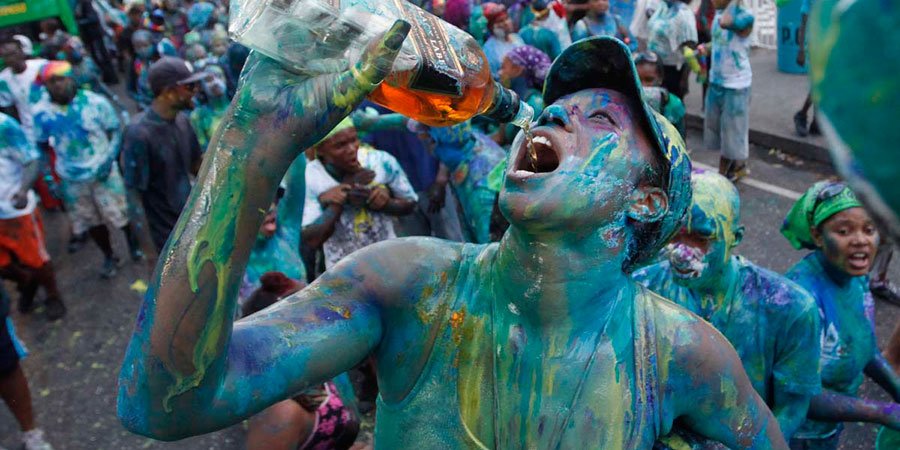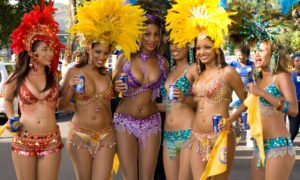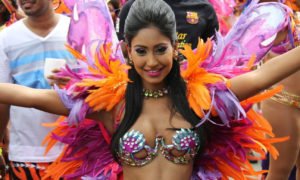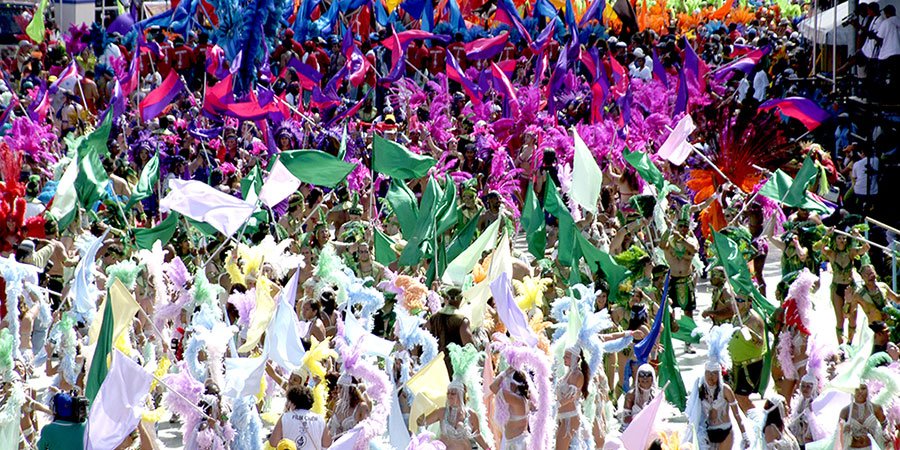The Trinidad Carnival focuses around three themes: Music, Movement and Mas. As a tourist visiting Trinidad, you will often hear various terms over and over during the Carnival. The following is a comprehensive list of popular terms used during the Trinidad Carnival. This Carnival glossary will help you speak Carnival talk just like a local.
ASH WEDNESDAY
Ash Wednesday is the first day of lent.
BAND
A collective of people who come together and take to the streets for Carnival
CARNIVAL
Coming from the Latin ‘Carne Vale’ farewell to meat before the fast of lent.
CALYPSO TENTS
Calypso tents are venues in which calypso performers perform during the Carnival season. They usually are cinema halls, community centers, or other indoor buildings which have seating and stage arrangements to host the entertainers, guests and patrons; or outdoor shows which are held in parks or, more famously, in the Queen’s Park Savannah. Throughout the carnival season, various areas throughout Trinidad & Tobago are converted to Calypso tents. These Calypso tents often hold massive parties and special functions. In Port of Spain, the two most popular Calypso tents are Jean Pierre Complex and Deluxe Cinema located on Keate St.
DIMANCHE GRAS
The major show on Carnival Sunday night when eight King and eight Queen of the bands costumes (some 30 feet tall) compete on stage to be named King and Queen of Carnival. The eight top singers compete to be crowned the Calypso Monarch.
FETES
In the run up to carnival everyone holds parties, known as jump up or fetes (pronounce fett) with lots of music and opportunities to display the latest moves and with good things to eat and drink. Fetes are typically Soca or Calypso oriented parties around Carnival time.
FLOAT
A decorated vehicle that takes part in the procession.
J’OUVERT
Pronounced “Jou-vay” and also spelt ‘joovay’, ‘jouvay’ and ‘jouvert’, this term comes from the French Jour ouvert – opening of the day or daybreak – and is the first act when Carnival takes to the Streets. J’ouvert is the beginning carnival itself. In the earliest hours of Monday morning, groups gather at appointed street corners and parks, to set off down the street in darkness to the driving beat of tin cans, bottle and spoon and similar improvised instruments or a small section from a steel band.
Costuming is usually minimal, often satirical, lewd, and bizarre. Mud and paint mas are also popular, with players covering themselves, and anyone they meet and hug, with mud, paint, grease or flour. J’ouvert revelers occupy the street till dawn comes and the sun begins to warm the day.
The word ‘j’ouvert’ comes from the French ‘jour ouvert’, meaning ‘daybreak’. The jouvay celebration in carnival is believed to have developed in the 1880s
JUDGING POINT
This is the point where all the carnival bands will get judged on their carnival costume. Marking will include use of colour, creativeness and historic background
JUMP UP
In the run up to carnival everyone holds parties, known as jump up or fetes with lots of music and opportunities to display the latest moves and with good things to eat and drink.
KING OF CARNIVAL
The King of Carnival – There is always a prize given to the best costume and its wearer who then becomes the King of Carnival.
LENT
The Catholic holiday of which the Trinidadian Carnival was celebrated for.
LIME
To lime is to spend time relaxing and talking with friends and acquaintances, on the street, in the park or round somebody’s home. It’s informal, light-hearted and often includes drinking. You will ofen hear Trinis use it as a verb: limeing.
MARDI GRAS
The term comes from the French, literally meaning ‘Fat Tuesday’. Mardi Gras is Shrove Tuesday in the Christian calendar, the day when traditionally Christians ate and drank as much as they could before the beginning of Lent and forty days of fasting.
MAS
Coming from the French word ‘masquerade‘ a word used for all traditions surrounding costume making and wearing.
MAS CAMP
A Mas camp is the place where a Carnival band carries out its work. Carnival participants can visit the mas camp for complete information on carnival masquerade bands, view costumes in each section of a masquerade band, be fitted for a costume before purchase and other related activities that occur during a carnival mardi gras.
In Trinidad & Tobago, a mas band is often a year round business, it may have permanent base in factory-type premises or take over a house. This is where the costumes are made, meals cooked for the makers and the general business of preparation for carnival takes place.
MOCO JUMBIE
Stilt dancers, an African tradition carried over to Trini carnival their costumes represent jumbies, or spirits, of African mythology.
PAN (Steelpans)
Pan is short for steelpans (also known as steel drums and sometimes, collectively with other musicians, as a steel band or orchestra) is a musical instrument originating from Trinidad and Tobago. Steel pan musicians are called pannists. The pan is the national instrument of Trinidad and Tobago.
PANORAMA
Panorama is an annual music competition of Steelbands from Trinidad and Tobago. It is usually held around Carnival time.
PANYARD
A panyard is often where pannists come to make contact with other pan players and share their music. Every village in Trinidad & Tobago has a steelband with its own panyard. The location of Panyards for the carnival are usually known months in advance and it is possible for the general public to visit a panyard.
PLAY MAS
This is what many people all over the world come to Trinidad to do. You dress up in your beautiful costume and play mass down the road. Dance, sing, drink, socialise etc down the carnival route.
QUEEN OF CARNIVAL
Traditionally there is always a prize given to the best costume and its wearer who then becomes the Queen of Carnival.
STEELPAN
One of the most unique and beautifully sounding instruments given birth in Trinidad and believed to be the only percussion instrument introduced the 20th century. For more info, see Pan.
WINING
Wining describes the gyrating of spiraling movement of hips and pelvis in carnival dancing. It probably derives from ‘winding’, as in ‘winding round’.















